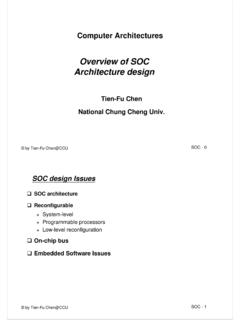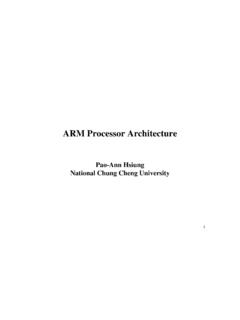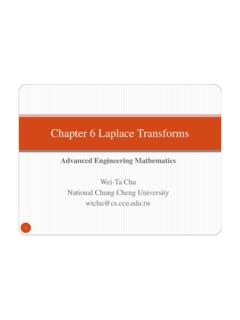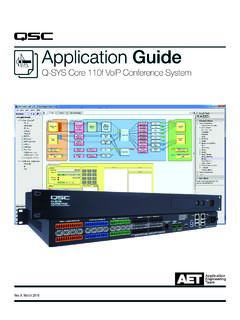Transcription of Lecture 3 Complex Exponential Signals
1 Fundamentals of digital signal ProcessingLecture 3 Complex Exponential SignalsFundamentals of digital signal ProcessingSpring, 2012 Wei-Ta Chu2012/3/11 DSP, CSIE, CCUR eview of Complex NumbersDSP, CSIE, CCU2 Using Euler s famous formula for the Complex Exponential The Complex Exponential polar form of a Complex number is most convenient when calculating a Complex multiplication or division. (see Appendix A) Complex Exponential Signals The Complex Exponential signal is defined as It s a Complex -valued function of t, where the magnitude of z(t) is |z(t)|=Aand the angle of z(t) is Using Euler s formulaDSP, CSIE, CCU3 Using Euler s formula The real part is a real cosine signal as defined previously. Complex Exponential Signals Example: , CSIE, CCU4 Complex Exponential Signals The main reason we are interested in the Complex Exponential signal is that it is an alternative representation for the real cosine signal . DSP, CSIE, CCU5 The Rotating Phasor Interpretation When two Complex numbers are multiplied, it s best to use the polar form: We multiply the magnitudes and add the angles.
2 This geometric view of Complex multiplication leads DSP, CSIE, CCU6 This geometric view of Complex multiplication leads to a useful interpretation of the Complex Exponential signal as a Complex vector that rotates as time Rotating Phasor Interpretation Define the Complex number Then z(t) is the product of the Complex number Xand the Complex -valued time functionX, which is called the Complex amplitude, is a polar DSP, CSIE, CCU7 X, which is called the Complex amplitude, is a polar representation created from the amplitudeand the phase shiftof the Complex Exponential signal . The Complex amplitude is also called a phasor( , ). The Rotating Phasor Interpretation z(t) is a Complex number whose magnitude is Aand whose argument is z(t) can be represented as a vector in the Complex planeDSP, CSIE, CCU8 z(t) can be represented as a vector in the Complex plane The vector always lies on the perimeter of a circle of radius A. As tincreases, z(t) will rotate at a constant rate, determined by The Rotating Phasor Interpretation Multiplying the phasorXby causes the fixed phasorXto rotate.
3 Since , no scaling occurs. Another name for the Complex Exponential is rotating phasor. DSP, CSIE, CCU9phasor. The Rotating Phasor Interpretation If the frequency is positive, the direction of rotation is counterclockwise, because will increase with increasing time. Rotating phasors are said to have positive frequencyif they rotate counterclockwise, and negative frequencyif they rotate clockwise. DSP, CSIE, CCU10they rotate clockwise. A rotating phasor makes one complete revolution every time the angle changes by radians. The phase shift defines where the phasor is pointing when t=0 The Rotating Phasor Interpretationat The real part of z(t) at DSP, CSIE, CCU11As tincreases, the rotating phasorz(t) rotates in the counterclockwise direction, and its real part x(t) oscillates left and right along the real axis. The Rotating Phasor Interpretation DemoDSP, CSIE, CCU12 Inverse Euler Formulas(see Appendix A for details)DSP, CSIE, CCU13* denotes Complex conjugationThe real cosine signal is actually composed of two Complex Exponential Signals : one with positive frequency ( ) and the other with negative frequency ( ).
4 It can be represented as the sum of two Complex rotating phasors that are Complex conjugates of each other. The real sine signal is also composed of two Complex Exponential , see Exercise Euler FormulasAs tincreases, the angle would increase in the counterclockwise direction. DSP, CSIE, CCU14 Phasor Addition There are many situations in which it s necessary to add two or more sinusoidal Signals . Now we add several sinusoids having the same frequency, but with different amplitudes and phases. A sum of Ncosine Signals of different amplitudes and phase shifts, but with the same frequency, can always be DSP, CSIE, CCU15phase shifts, but with the same frequency, can always be reduced to a single cosine signal of the same frequency. Phasor AdditionDSP, CSIE, CCU16 Addition of Complex NumbersDSP, CSIE, CCU17 Phasor Addition Rule Any sinusoid can be written in the form: amplitudeDSP, CSIE, CCU18 For any set of Complex number {Xk} the sum of the real parts is equal to the real part of the sum, so we havePhasor Addition RuleDSP, CSIE, CCU19 ExampleThe frequency is 10 Hz, so the period is T0= , CSIE, CCU20tm1= (a) Represent x1(t) and x2(t) by the phasors: (b) Convert both phasors to rectangular form: (c) Add the real parts and the imaginary parts: DSP, CSIE, CCU21 (d) Convert back to polar form, obtaining The final formula for x3(t) isSummary of the Phasor Addition Rule (a) Obtain the phasor representation of each of the individual Signals (b) Add the phasors of the individual Signals to get.
5 This requires polar-to-Cartesian-to polar format conversions. DSP, CSIE, CCU22 Cartesian-to polar format conversions. (c) Multiply Xby to get (d) Take the real part to get Homework 1 Exercises , , , Hand over your homework at the class of Mar. 8 DSP, CSIE, CCU23 Fundamentals of digital signal ProcessingLecture 3 Spectrum RepresentationFundamentals of digital signal ProcessingSpring, 2012 Wei-Ta Chu2012/3/124 DSP, CSIE, CCUS pectrum ( ) Spectrum: a compact representation of the frequency content of a signal that is composed of sinusoids. We will show how more complicated waveforms can be constructed out of sums of sinusoidal Signals of different amplitudes, phases, and frequencies. A signal is created by adding a constant and NDSP, CSIE, CCU25 A signal is created by adding a constant and Nsinusoids Such a signal may be represented in terms of the Complex amplitudeSpectrum By using inverse Euler formula The real part of a Complex number is equal to one-half DSP, CSIE, CCU26 The real part of a Complex number is equal to one-half the sum of that number and its Complex conjugate.
6 Each sinusoid in the sum decomposes into two rotating phasors, one with positive frequency, , and the other with negative frequency, .Spectrum Two-sided spectrum of a signal composed of sinusoids as Set of pairsDSP, CSIE, CCU27 Each pair indicates the size and relative phase of the sinusoidal component contributing at frequency Frequency-domain representationof the signal Example Apply inverse Euler formulaDSP, CSIE, CCU28 The constant component of the signal , often called the DC component, can be expressed as . The spectrum of the signal is represented byNotation Change Introduce a new symbol for the Complex amplitude in the spectrum The spectrum is the set of (fk, ak) pairsDefine f= 0. Now we can rewrite DSP, CSIE, CCU29 Define f0= 0. Now we can rewrite Graphical Plot of the Spectrum Spectrum plot of This plot shows the relative location of the frequencies, and the relative amplitudes of the sinusoidal componentsDSP, CSIE, CCU30the relative amplitudes of the sinusoidal components The rotating phasors with positive and negative frequency must combine to form a real signalSpectrum A general procedure for computing and plotting the spectrum for an arbitrarily chosen signal requires the study of Fourier analysis.
7 If it s known a priori that a signal is composed of a finite number of sinusoidal components, the process of analyzing that signal to find its spectral components involves writing an equation for the signal in the form DSP, CSIE, CCU31involves writing an equation for the signal in the form of and picking off the amplitude, phase, and frequency of each of its rotating phasor components










